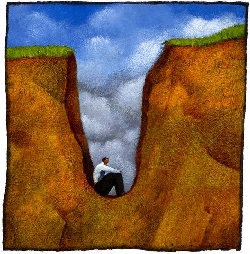- Getting out is a lot harder than getting in.
 I wore shorts to work the other day. Yea, I know, I'm the guy that says we should spruce up our image at work, but I did this to revolt against the rut I've gotten into in the morning (plus it was a Friday and I knew I wouldn't be running into anybody). Like a lot of guys, when I get up, I have a light breakfast, scan the newspaper, shave, shower, get dressed for the day, and drive to work. It is all very boring and repetitive and frankly, I think I finally blew a fuse.
I wore shorts to work the other day. Yea, I know, I'm the guy that says we should spruce up our image at work, but I did this to revolt against the rut I've gotten into in the morning (plus it was a Friday and I knew I wouldn't be running into anybody). Like a lot of guys, when I get up, I have a light breakfast, scan the newspaper, shave, shower, get dressed for the day, and drive to work. It is all very boring and repetitive and frankly, I think I finally blew a fuse.
It's easy to get into a rut regardless if you are a man or a woman. Whether you call it a rut or "writer's block," the danger is that you become stale and complacent and don't think clearly. This is when productivity in the office is threatened by laziness and lack of concentration. I think this is why the vacation was invented, so that a change of scenery will perhaps reinvigorate us. It pays to try and ride a different horse now and then.
Office managers should also be wary of workers falling into a rut. We may not be able to send them on an all expense-paid trip to Aruba, but we can do other things, such as reorganizing the furniture, adding a touch of paint here and there, adjusting the lighting and sound, introducing some new office equipment, etc. In other words, something for the workers to take note of and react to.
In order to get your workers out of a rut, you have to do something that stimulates their five senses and intellect, perhaps a new type of assignment or job. If left unchecked, the tedium of a monotonous working environment will eventually drive away your employees, even the best of them.
I had an occasion to visit a Sony factory in Japan years ago. While there, I observed an assembly line where the various workers built television sets. Each workstation had its own set of responsibilities for adding components and checking the work that preceded them on the line. However, on the hour, a whistle would blow, whereby the workers would back away from the workstations and perform some simple calisthenics to relieve the monotony. If that wasn't enough, each worker then rotated to the next workstation in the line where the work resumed. This made each worker cognizant of all of the steps needed to assemble the television set, as well as to promote the development of a quality product. I found this routine to be a simple yet effective approach for combating tedium.
You also find managers who promote end of week parties in the workplace or perhaps hold special training sessions to develop skills. However, I tend to believe the best solutions are the simple ones, such as the Sony example. I don't normally recommend wearing shorts to work as a way to combat repetition, particularly if customers are going to be around. Instead, just pay a little more attention to the five senses of your workers. It can work miracles.
Originally published: July 14, 2008
Keep the Faith!
Note: All trademarks both marked and unmarked belong to their respective companies.
 Tim Bryce is a writer and the Managing Director of M&JB Investment Company (M&JB) of Palm Harbor, Florida and has over 30 years of experience in the management consulting field. He can be reached at timb001@phmainstreet.com
Tim Bryce is a writer and the Managing Director of M&JB Investment Company (M&JB) of Palm Harbor, Florida and has over 30 years of experience in the management consulting field. He can be reached at timb001@phmainstreet.com
For Tim's columns, see: timbryce.com
Like the article? TELL A FRIEND.
Copyright © 2015 by Tim Bryce. All rights reserved.
NEXT UP: DEMOCRATIC MANAGEMENT? - Look carefully before you leap into "Holacracy."
LAST TIME: ACADEMIC QUACKS - "Theorists" versus "Practicals."
Listen to Tim on WJTN-AM (News Talk 1240) "The Town Square" with host John Siggins (Mon, Wed, Fri, 12:30-3:00pm Eastern); WZIG-FM (104.1) in Palm Harbor,FL; and KIT-AM 1280 in Yakima, Washington "The Morning News" with hosts Dave Ettl & Lance Tormey (weekdays. 6:00-9:00am Pacific). Or tune-in to Tim's channel on YouTube.
No comments:
Post a Comment